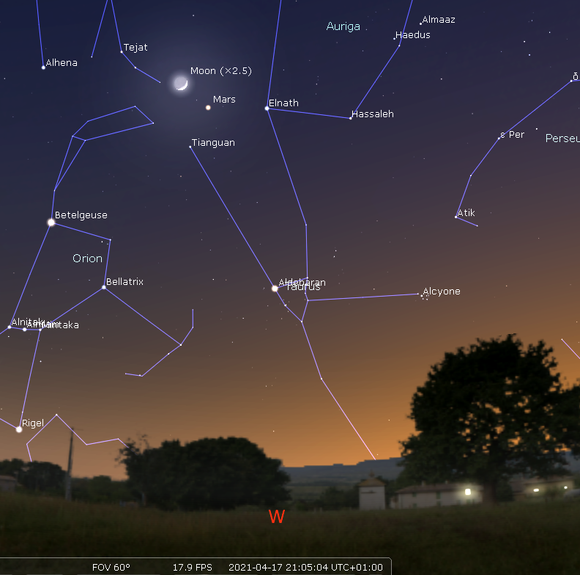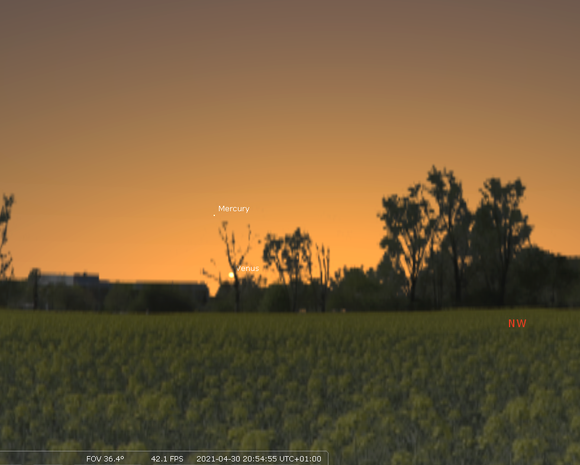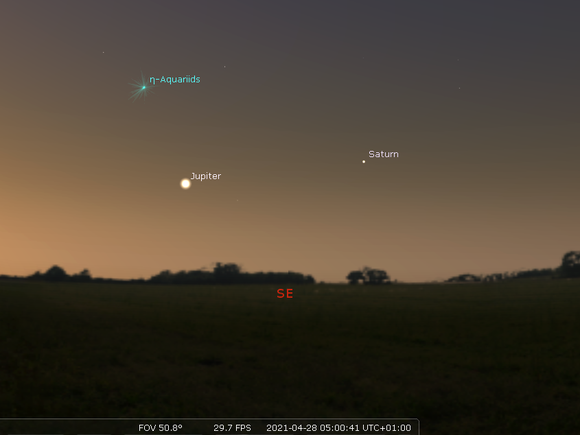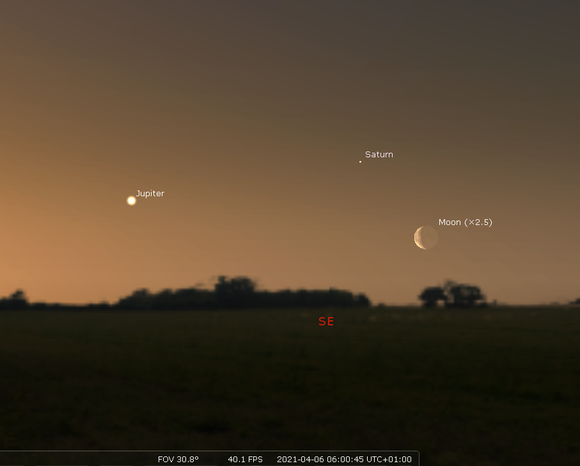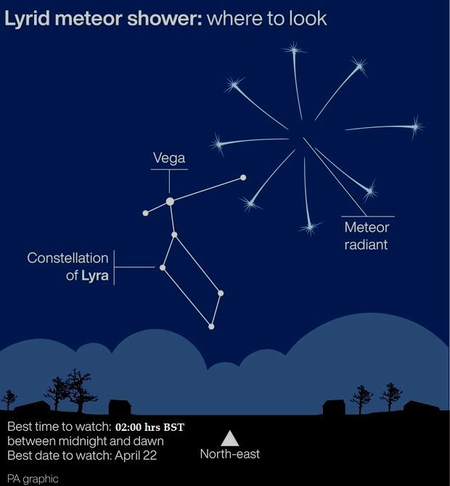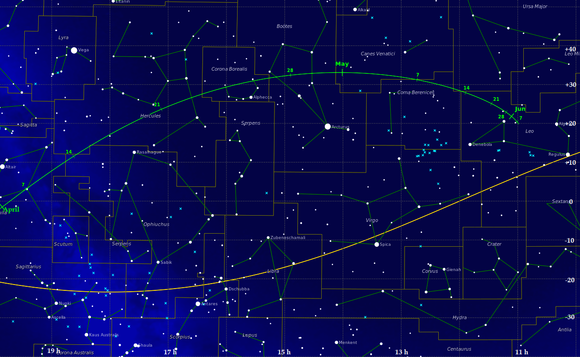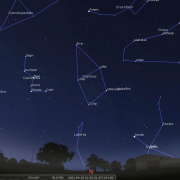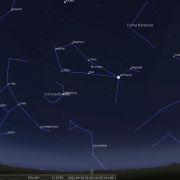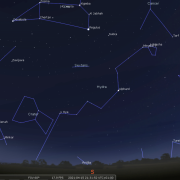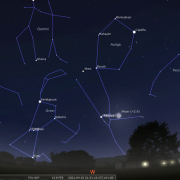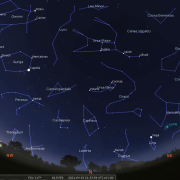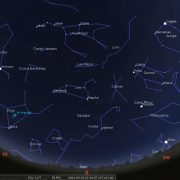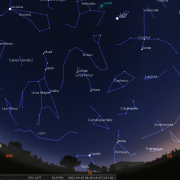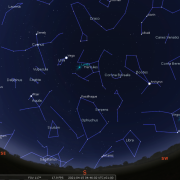In this month's Sky Notes:
Planetary Skylights - Brief
For most of April Mars will remain the only naked eye planet visible in the evening sky, however in the dying days of the month both Mercury and Venus reappear just above the WNW horizon, but will be a little challenging to spot. Jupiter and Saturn continue to be elusive objects in the dawn sky, not far above the ESE horizon.
 As April begins, Mars resides in the west as twilight deepens, moving slowly between the 'horn' stars in Taurus and toward the feet of Gemini roughly two handspans above the W horizon. Over the course of the month the 'red planet' fades from mag +1.3 to mag +1.5 and is just over 5 arc seconds in diameter. If you do fancy imaging Mars you will need to be well prepared, it is above the horizon for less than 90 minutes, setting just before 23:00hrs at the start of the month. The waxing crescent moon pays Mars a visit on the 17th making for a pleasant vista.
As April begins, Mars resides in the west as twilight deepens, moving slowly between the 'horn' stars in Taurus and toward the feet of Gemini roughly two handspans above the W horizon. Over the course of the month the 'red planet' fades from mag +1.3 to mag +1.5 and is just over 5 arc seconds in diameter. If you do fancy imaging Mars you will need to be well prepared, it is above the horizon for less than 90 minutes, setting just before 23:00hrs at the start of the month. The waxing crescent moon pays Mars a visit on the 17th making for a pleasant vista.
 At the very end of April, Mercury commences a favourable evening apparition lasting well into May. It can be glimpsed very low in the WNW 40- 45 minutes after sunset (around 21:00 hrs BST). Mercury will appear barely 4 degrees above the horizon, so a clear, uninterrupted aspect is a prerequisite to stand any chance of spotting the 'elusive messenger', which at mag -1.2 will be reasonably conspicuous in the twilight sky. If you observe on the 29th or 30th, do not mistake it for brighter Venus, which is visible below Mercury, even closer to the horizon!
At the very end of April, Mercury commences a favourable evening apparition lasting well into May. It can be glimpsed very low in the WNW 40- 45 minutes after sunset (around 21:00 hrs BST). Mercury will appear barely 4 degrees above the horizon, so a clear, uninterrupted aspect is a prerequisite to stand any chance of spotting the 'elusive messenger', which at mag -1.2 will be reasonably conspicuous in the twilight sky. If you observe on the 29th or 30th, do not mistake it for brighter Venus, which is visible below Mercury, even closer to the horizon!
 To spot both Venus and Mercury you will need to observe from 20:50hrs - 21:05 BST, after which Venus will have set, so it will be quite challenging, allowing little time to pick them out of the twilight sky. Use binoculars to sweep the WNW horizon, keeping the horizon just in view. Both planets will appear in the same field of view. Once you have picked them out using binoculars, try with just the naked eye. Both will be better placed next month, Mercury especially so.
To spot both Venus and Mercury you will need to observe from 20:50hrs - 21:05 BST, after which Venus will have set, so it will be quite challenging, allowing little time to pick them out of the twilight sky. Use binoculars to sweep the WNW horizon, keeping the horizon just in view. Both planets will appear in the same field of view. Once you have picked them out using binoculars, try with just the naked eye. Both will be better placed next month, Mercury especially so.
Dawn Planets
 Jupiter continues to creep slowly away from the SE horizon, but remains only 10 degrees up. It is however pretty conspicuous at magnitude -2.1, although the twilight sky tends to negate this somewhat. You will need to be up around 0545hrs to spot Jupiter (earlier still by the month's end) and given the limited viewing time (35 minutes at most from UK latitudes), telescopic observations will be severely hampered, so perhaps just concentrate on using binoculars or the naked eye for the time being.
Jupiter continues to creep slowly away from the SE horizon, but remains only 10 degrees up. It is however pretty conspicuous at magnitude -2.1, although the twilight sky tends to negate this somewhat. You will need to be up around 0545hrs to spot Jupiter (earlier still by the month's end) and given the limited viewing time (35 minutes at most from UK latitudes), telescopic observations will be severely hampered, so perhaps just concentrate on using binoculars or the naked eye for the time being.
 Some 15 degrees east of Jupiter and just 3 degrees higher, Saturn also wallows low in the SE dawn sky. At mag +0.73 the ringed planet is considerably less conspicuous than Jupiter, but binoculars will help pick it out if not immediately apparent to the naked eye. To confirm that it is Saturn, a telescope will be required to reveal the rings, although at this stage viewing will be poor, and with limited time availability patience may be better served later in the year. The waning crescent moon lies below right of Saturn on the 6th at 0600hrs
Some 15 degrees east of Jupiter and just 3 degrees higher, Saturn also wallows low in the SE dawn sky. At mag +0.73 the ringed planet is considerably less conspicuous than Jupiter, but binoculars will help pick it out if not immediately apparent to the naked eye. To confirm that it is Saturn, a telescope will be required to reveal the rings, although at this stage viewing will be poor, and with limited time availability patience may be better served later in the year. The waning crescent moon lies below right of Saturn on the 6th at 0600hrs
Meteors - The Lyrids

April’s most prolific meteor shower; the Lyrids, are active from April 16th until April 25th, peaking over the night of the 21/22nd. The Lyrids are associated with comet Thatcher (C/186 G1) a periodic comet taking approximately 415 years to orbit the Sun. The comet last visited us in 1861. Each April, Earth ploughs through debris left behind by the comet giving rise to the shooting stars we observe. Lyrids are typically as bright as a second magnitude star, but as with most meteor showers there is always the chance of witnessing something a great deal brighter. These so called ‘Lyrid fireballs’ can exceed Venus in brilliance. Such shooting stars can momentarily cast a shadow, sometimes leaving behind smoking debris trails that can linger for over a minute. The vast majority of meteors are however no bigger in size than instant coffee granules, even really brilliant examples will only be marble sized!
The radiant of the shower lies not far from Vega, the brilliant steely blue star in Lyra. In the post midnight hours, Lyra is rising into the northeast part of the sky. Observing at such a time, expect to spot 8-12 meteors per hour on the morning of the 22nd. Do not however look in the direction of Lyra, but instead view at least two hand spans away from it. The downside this year is that the Moon will hamper observations, being two days beyond first quarter.
The Lyrids - April 21/22 (click for larger image)
image credit BBC science focus magazine https://www.sciencefocus.com/
A number of lesser meteor showers occur during April. The Virginids and alpha Scorpiids each have zenith hourly rates (ZHR) of half a dozen or so, equating to ‘normal’ sporadic meteor activity levels. The Virginids peak over the night of April 7/8th, which is a favourable period coinciding with waning crescent moon. The Scorpiids peak on the 27th, which is a full moon night.
Comet 2020 ATLAS R4
Remember the spectacular passage of comet NEOWISE late last spring? This turned out to be brighter than forecast and was a real tonic in the first lockdown period. Welll, we may have another comet that warrants attention this spring, although it has to be said from the off that Comet 2020 ATLAS R4 is unlikely to become a naked eye object...probably. Like NEOWISE, comet ATLAS R4 is a long orbital period comet which returns every 934 years. The comet was discovered in mid-September 2020 when still only 19th magnitude. After surviving perihelion passage (closest approach to the Sun) on 1 March, when the comet passed by the sun at a distance of around 154 million kilometres (95 million miles), or 1.03 astronomical units (AU), ATLAS R4 has just emerged into the UK pre-dawn sky as a binocular object, with most recent estimates of brightness at +8.1. At the start of April the comet will lie at an altitude of around 24 degrees by the beginning of nautical twilight (around 5.20am BST or 04:20 UT). It will then lie three degrees south of magnitude +3.9 eta (η) Aquilae. The comets motion will then pick up the pace as it draws closer.
Chart for Comet ATLAS R4 April-June. (click for larger image)
Chart credit Dominic Ford https/in-the-sky.org
By the time of closest approach to Earth on April 23rd, comet ATLAS will have become an evening object with an elevation of almost 30 degrees in the eastern sky at the end of nautical twilight, around 21:30 BST and will reside amongst the stars of Corona Borealis. It culminates at about 0300am BST (02:00 UT), almost 70 degrees up. Comet ATLAS R4 may then be just shy of naked eye visibility (around 6.6 magnitude), but should be easily picked up in binoculars or a small scope. And you never know, it may behave as unpredictable as most comets do and become a naked eye object! Keep a watchful eye online for the latest on ATLAS R4.
April 2021 Sky Charts
Additional Image Credits:
- Planets and Comets where not otherwise mentioned: NASA
- Sky Charts: Stellarium Software and Starry Night Pro Plus 8.
- Log in to post comments

